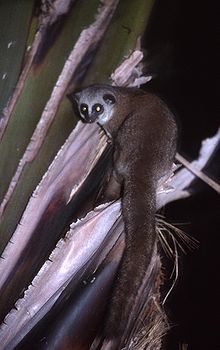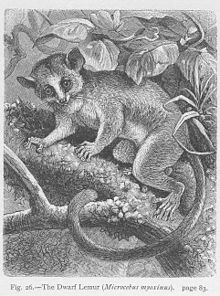| Revision as of 19:24, 5 November 2020 editCitation bot (talk | contribs)Bots5,458,034 edits Alter: isbn, url. URLs might have been internationalized/anonymized. Correct ISBN10 to ISBN13. | You can use this bot yourself. Report bugs here. | Suggested by AManWithNoPlan | All pages linked from cached copy of User:AManWithNoPlan/sandbox2 | via #UCB_webform_linked 647/2899← Previous edit | Revision as of 17:00, 25 February 2021 edit undoTom.Reding (talk | contribs)Autopatrolled, Extended confirmed users, Page movers, Template editors3,933,900 editsm +{{Authority control}} (1 ID from Wikidata), WP:GenFixes onTag: AWBNext edit → | ||
| Line 4: | Line 4: | ||
| | name = Dwarf lemurs | | name = Dwarf lemurs | ||
| | image = CHEIROGALEUS-1.JPG | | image = CHEIROGALEUS-1.JPG | ||
| | image_caption = Greater dwarf lemur{{ |
| image_caption = Greater dwarf lemur{{Clear}}(''Cheirogaleus major'') | ||
| | status = CITES_A1 | | status = CITES_A1 | ||
| | status_system = CITES | | status_system = CITES | ||
| Line 47: | Line 47: | ||
| Dwarf lemurs roam the lower strata of the foliage in the coastal forests of eastern Madagascar. They are ] and ]. They have a period of inactivity (]) during the winter season lasting between four and five months. Their tail serves as an area for fat storage, most of which is consumed during periods of food scarcity. Like most nocturnal prosimians, dwarf lemurs are reported as living solitary or in pairs. They nest in tree holes where they often sleep together in curled up positions. Their territories are marked by fecal and scent markings. Their diet consists primarily of fruits and flowers and they seem to play a part in the pollination of certain plants. | Dwarf lemurs roam the lower strata of the foliage in the coastal forests of eastern Madagascar. They are ] and ]. They have a period of inactivity (]) during the winter season lasting between four and five months. Their tail serves as an area for fat storage, most of which is consumed during periods of food scarcity. Like most nocturnal prosimians, dwarf lemurs are reported as living solitary or in pairs. They nest in tree holes where they often sleep together in curled up positions. Their territories are marked by fecal and scent markings. Their diet consists primarily of fruits and flowers and they seem to play a part in the pollination of certain plants. | ||
| <ref name="Ankel-Simon" /><!--- ref for entire section ---> | <ref name="Ankel-Simon" /><!--- ref for entire section ---> | ||
| {{ |
{{Clear|left}} | ||
| == Classification == | == Classification == | ||
| Line 64: | Line 64: | ||
| == See also == | == See also == | ||
| {{ |
{{Commons category|Cheirogaleus}} | ||
| {{Wikispecies|Cheirogaleus}} | {{Wikispecies|Cheirogaleus}} | ||
| * ] | * ] | ||
| Line 74: | Line 74: | ||
| {{Cheirogaleidae nav}} | {{Cheirogaleidae nav}} | ||
| {{Taxonbar|from=Q608001}} | {{Taxonbar|from=Q608001}} | ||
| {{Authority control}} | |||
| ] | ] | ||
Revision as of 17:00, 25 February 2021
| Dwarf lemurs | |
|---|---|

| |
| Greater dwarf lemur(Cheirogaleus major) | |
| Conservation status | |
| CITES Appendix I (CITES) | |
| Scientific classification | |
| Domain: | Eukaryota |
| Kingdom: | Animalia |
| Phylum: | Chordata |
| Class: | Mammalia |
| Order: | Primates |
| Suborder: | Strepsirrhini |
| Family: | Cheirogaleidae |
| Genus: | Cheirogaleus É. Geoffroy, 1812 |
| Type species | |
| Cheirogaleus major É. Geoffroy, 1812 | |
| Species | |
| Synonyms | |
| |
The dwarf lemurs are the lemurs of the genus Cheirogaleus. All of the species in this genus, like all other lemurs, are native to Madagascar.
Description

Measuring 19–27 cm in body length with a tail about 16–17 cm, they are larger than the mouse lemur but smaller than the gentle lemur. Their heads are globular compared to the fox-like heads of the lemurs, but their muzzles are more pointed than those of the hapalemurs. Their hind limbs are slightly longer than their forelimbs, but not as elongated as in lepilemurs or indriids. Dwarf lemurs have an intermembral index of 71 on average. In contrast to most other primates, their grip is similar to that of South American monkeys with objects picked up and branches grasped between the second and third fingers, rather than between the thumb and index finger. Their nails are somewhat keeled and pointed.
Dwarf lemurs roam the lower strata of the foliage in the coastal forests of eastern Madagascar. They are nocturnal and quadrupeds. They have a period of inactivity (torpor) during the winter season lasting between four and five months. Their tail serves as an area for fat storage, most of which is consumed during periods of food scarcity. Like most nocturnal prosimians, dwarf lemurs are reported as living solitary or in pairs. They nest in tree holes where they often sleep together in curled up positions. Their territories are marked by fecal and scent markings. Their diet consists primarily of fruits and flowers and they seem to play a part in the pollination of certain plants.
Classification
As of 2018, 9 species are known.
- Genus Cheirogaleus: dwarf lemurs
- Montagne d'Ambre dwarf lemur, Cheirogaleus andysabini
- Furry-eared dwarf lemur, Cheirogaleus crossleyi
- Groves' dwarf lemur, Cheirogaleus grovesi
- Lavasoa dwarf lemur, Cheirogaleus lavasoensis
- Greater dwarf lemur, Cheirogaleus major
- Fat-tailed dwarf lemur, Cheirogaleus medius
- Lesser iron-gray dwarf lemur, Cheirogaleus minusculus
- Ankarana dwarf lemur, Cheirogaleus shethi
- Sibree's dwarf lemur, Cheirogaleus sibreei
See also
References
- ^ Groves, C. P. (2005). "Genus Cheirogaleus". In Wilson, D. E.; Reeder, D. M (eds.). Mammal Species of the World: A Taxonomic and Geographic Reference (3rd ed.). Johns Hopkins University Press. pp. 111–112. ISBN 978-0-8018-8221-0. OCLC 62265494.
- Harcourt, C. (1990). Thornback, J (ed.). Lemurs of Madagascar and the Comoros: The IUCN Red Data Book (PDF). World Conservation Union. ISBN 978-2-88032-957-0. OCLC 28425691.
- McKenna, MC; Bell, SK (1997). Classification of Mammals: Above the Species Level. Columbia University Press. p. 335. ISBN 0-231-11013-8.
- ^ Ankel-Simons, Friderun (2007). Primate Anatomy : An Introduction (3rd ed.). Durham, North Carolina: Department of Biological Anthropology and Anatomy, Duke University. pp. 55–56. ISBN 978-0-12-372576-9.
| Taxon identifiers | |
|---|---|
| Cheirogaleus | |